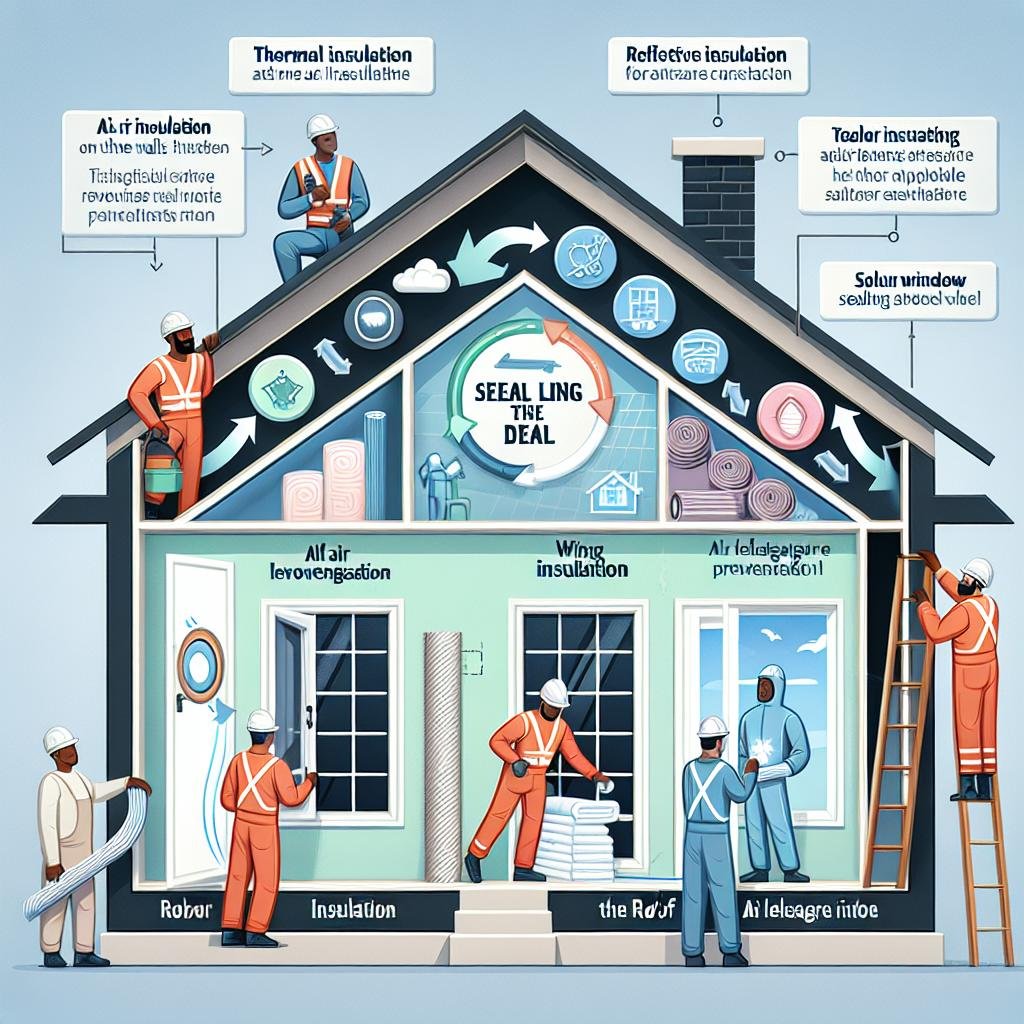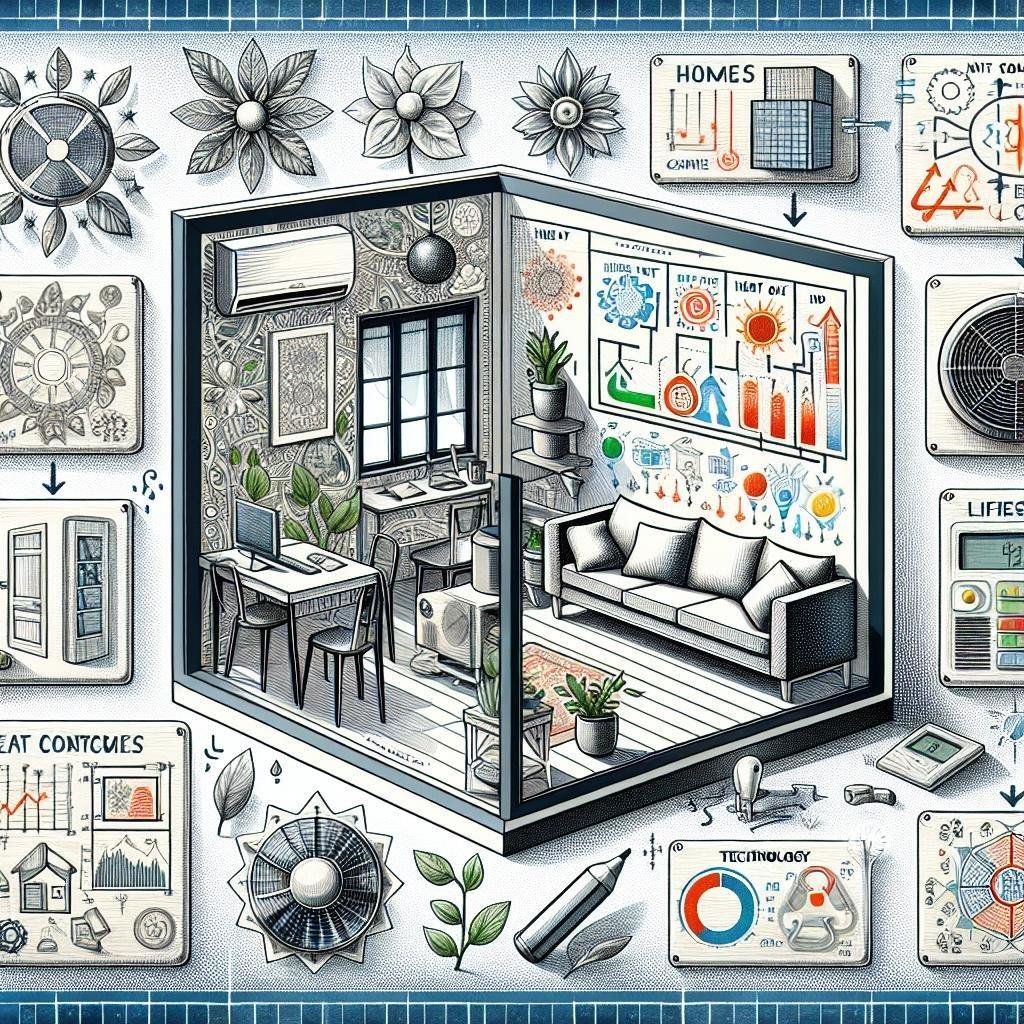Introduction
As the sweltering heat of summer rolls in, we find ourselves reaching for the cool comfort of our trusty mini-split air conditioning systems. These sleek units are champions of efficiency, but like any good team player, they thrive when the playing field is in their favor. Whether you’re in a sun-drenched loft or a cozy basement retreat, understanding the ins and outs of heat gain and heat loss is essential for maximizing your mini-split’s performance.
Think of your space as a living organism—every window, wall, and door contributes to its temperature dynamics. In this article, we’ll take a friendly yet informative stroll through the world of thermal efficiency, uncovering potential sources of unwanted heat and cold. Together, we’ll tackle practical strategies to not only enhance your comfort but also reduce energy costs and boost the effectiveness of your mini-split AC system. Say goodbye to sweltering afternoons and chilly evenings, and let’s start optimizing the sanctuary of your home!
Understanding Your Space: Identifying Key Areas of Heat Gain and Loss
To create a comfortable environment while maximizing your Mini Split AC system’s efficiency, it’s essential to pinpoint where heat enters and escapes your space. Start by surveying common culprits that contribute to heat gain. Windows often sit at the forefront—single-pane options can let hot sunlight flood in, turning your living areas into warmer havens. Also, consider external walls, especially those exposed directly to sunlight. Insufficient insulation in these areas can lead to significant heat absorption during the day. And don’t forget about your roof, which can soak up heat like a sponge. By addressing these zones, you can take proactive measures to prevent unnecessary heat gain.
On the flip side, identifying areas where heat loss occurs is equally crucial to maintain a balanced indoor climate. A common issue is drafty windows and doors, which may allow conditioned air to escape. Using weatherstripping or caulking can seal these leaks and boost your energy efficiency. Additionally, attic spaces should not be neglected; without proper insulation, valuable cool air can escape. It’s beneficial to assess the flooring, particularly if it’s directly above an unconditioned basement or crawl space. Use the following table to summarize these key areas and their solutions:
| Area | Issue | Solution |
|---|---|---|
| Windows | Heat Gain | Install window films or use thermal curtains |
| External Walls | Heat Gain | Improve insulation or add exterior shading |
| Doors | Heat Loss | Weatherstripping or install door sweeps |
| Attic | Heat Loss | Enhance insulation and install air barriers |
| Flooring | Heat Loss | Insulate crawl spaces and basements |

Sealing the Deal: Effective Strategies for Insulation and Air Leakage Prevention
Effectively tackling insulation and air leakage is essential for maximizing the performance of your Mini Split AC system. Start by conducting a thorough inspection of your living space. Look for common problem areas where heat could infiltrate or escape, such as:
- Windows: Ensure they are properly sealed and consider adding weatherstripping or caulk.
- Doors: Check for gaps around frames and install door sweeps where necessary.
- Attics and Basements: Insulate these areas to prevent significant heat loss.
- Electrical Outlets: Use foam gaskets to seal leaks.
Moreover, enhancing insulation might require you to evaluate existing materials to ensure they are effective. Here’s a brief overview of insulation types versus their R-values:
| Insulation Type | R-value per inch |
|---|---|
| Fiberglass Batts | 2.9 – 4.3 |
| Foam Board | 4.0 – 8.0 |
| Spray Foam | 5.0 – 8.0 |
| Cellulose | 3.1 - 3.7 |
Improving your insulation strategy is integral to fortifying your home’s defense against unwanted heat exchange, allowing your Mini Split AC system to operate more efficiently and save energy in the process.

Shading Solutions: Utilizing Natural and Artificial Barriers for Temperature Control
Optimizing your Mini Split AC system involves more than simply adjusting temperatures; it also requires an understanding of how natural and artificial barriers can significantly impact temperature control in your space. Using strategic landscaping can not only enhance the beauty of your environment but also create a natural canopy that helps reduce heat gain in summer. For instance, positioning trees and shrubs around your home can provide essential shade, lowering ambient temperatures. Additionally, reflective surfaces like light-colored roofs or specialized window films can deflect solar radiation, contributing to a cooler indoor climate and working in tandem with your cooling system.
On the artificial side, utilizing architectural elements such as awnings, pergolas, and shutters can further enhance your space’s thermal performance. Consider these options for effective heat management:
- Awnings: Provide shade over windows and doors, decreasing sunlight exposure.
- Plantation Shutters: Allow for adjustable airflow and light control, minimizing heat gain during peak sun hours.
- Overhangs: Designed to block high summer sun while allowing low winter sunlight, these can optimize temperature throughout the year.
To better visualize these strategies, you can compare the effectiveness of various shading solutions in improving your Mini Split AC’s efficiency in the table below:
| Shading Solution | Heat Reduction Potential | Maintenance Level |
|---|---|---|
| Trees & Shrubs | High | Low |
| Awnings | Medium | Medium |
| Shutters | Medium | High |
| Reflective Window Films | High | Low |
By assessing the combination of these natural and artificial barriers, you can create a more energy-efficient environment that complements your Mini Split AC system, ensuring comfort while reducing energy consumption.

Optimizing Your Mini Split AC: Practical Tips for Performance and Energy Efficiency
To enhance the efficiency of your Mini Split AC system, it’s crucial to first identify and tackle any sources of heat gain or loss within your space. Start by conducting a thorough inspection of your home or office to pinpoint potential problem areas. Consider these common culprits:
- Windows: Leaky seals or single-pane glass can let outdoor heat seep in.
- Doors: Gaps under or around doors might allow hot air to enter.
- Insulation: Inadequate insulation in walls and ceilings can lead to temperature fluctuations.
- Ventilation: Poor ventilation systems can trap heat, making your AC work overtime.
Once you have identified these heat sources, implementing effective solutions is key. Start by sealing cracks and gaps with caulk or weatherstripping. For windows, consider adding thermal curtains or UV-blocking films to reduce heat during hot days. Here’s a simple table summarizing actions you can take to mitigate heat gain or loss:
| Source | Action |
|---|---|
| Windows | Install thermal curtains |
| Doors | Apply weatherstripping |
| Insulation | Add more insulation |
| Ventilation | Upgrade to a more efficient system |
By actively addressing these areas, you not only enhance the performance of your Mini Split AC but also create a more comfortable living environment. It’s all about creating a balance that keeps the cool air in and the heat out!
Q&A
Q&A: Assessing and Addressing Heat Gain and Loss for Mini Split AC Optimization
Q1: What exactly is heat gain and heat loss in a space?
A1: Think of your space as a cozy beach house! Heat gain is like a warm sunbeam sneaking in through the windows, making things toasty. On the flip side, heat loss is that sneaky breeze that nips in around drafty doors and chilly windows, making you reach for your sweater. Both can impact how efficiently your Mini Split AC system cools your home!
Q2: Why should I be concerned about heat gain and loss with my Mini Split AC?
A2: Great question! Your Mini Split AC is like a superhero, but it needs a little help to save the day. If your space lets in too much heat or loses it too quickly, your AC has to work overtime, which can lead to higher energy bills and shortened system life. By assessing these factors, you can ensure your AC runs smoothly and efficiently while keeping your space comfy!
Q3: How do I assess heat gain in my home?
A3: Channel your inner detective! Start by checking the windows—are they letting in sunlight? Use window treatments like shades or films to block out that blazing sun. Next, look at the walls and ceiling; poorly insulated surfaces can soak up heat. Have a peek at that roof too; dark colors can absorb heat like a sponge. take note of indoor heat sources like appliances and electronics, which can add to the warmth.
Q4: What about heat loss? How do I spot that?
A4: Time to put on your Sherlock hat again! Examine windows and doors for drafts—feel around the edges for chilly air. Look at insulation levels in your walls and attic; if they’re lackluster, heat is escaping like a secret agent. Don’t forget plumbing penetrations or outlets; they can be sneaky culprits too! Once you’ve identified hotspots, you can make changes.
Q5: How can I address the heat gain in my space?
A5: Time for action! Consider installing energy-efficient window treatments or double-glazed windows. If the walls are thin, adding insulation might do wonders! You could even plant shade trees outdoors or invest in awnings to shield your windows. Lastly, ensure your Mini Split AC is set to the correct size for your space—too small, and it’s a losing battle; too big, and it cools ineffectively.
Q6: And what can I do about heat loss?
A6: Seal those drafts! Weatherstripping or caulking around doors and windows can make a world of difference. Don’t forget to insulate those drafty attics and walls—this will help keep the heat inside. If you’re up for it, consider adding rugs to cozy up those chilly floors. And always keep your AC well-maintained; sometimes, a little TLC is all it needs!
Q7: How do I keep everything in check once I’ve addressed these issues?
A7: Regular check-ups are key! Schedule yearly maintenance for your Mini Split AC so it can keep its cool. Also, periodically reevaluate your home’s insulation and closure to stay ahead of the game. With a little vigilance, your space will remain the ultra-efficient paradise you’ve worked hard to create!
Q8: Any last words of wisdom?
A8: Absolutely! Remember, small changes can lead to big impacts, and optimizing your AC system doesn’t have to feel overwhelming. Embrace your journey to a more energy-efficient and comfortable living space. You’ve got this, and your Mini Split AC will thank you with cooler days ahead! 🌬️❄️
In Summary
As we wrap up our journey into the world of optimizing your Mini Split AC system, remember that creating a comfortable living space goes beyond simply adjusting the thermostat. By assessing and addressing sources of heat gain and heat loss, you’re not just enhancing your home’s energy efficiency, but also embracing a more sustainable lifestyle. With a few thoughtful tweaks—like sealing cracks, using reflective window treatments, and ensuring proper insulation—you can create an oasis of cool during hot summer days while keeping energy bills in check.
So, take a step back, look around your space, and don your detective hat! Each small adjustment can make a significant impact, and soon you’ll be basking in the comfort of a perfectly climate-controlled environment. Cheers to your success in mastering the art of temperature regulation, and here’s to enjoying the satisfying coolness that your Mini Split system provides—all while being a friend to both your wallet and the planet. Happy cooling!

